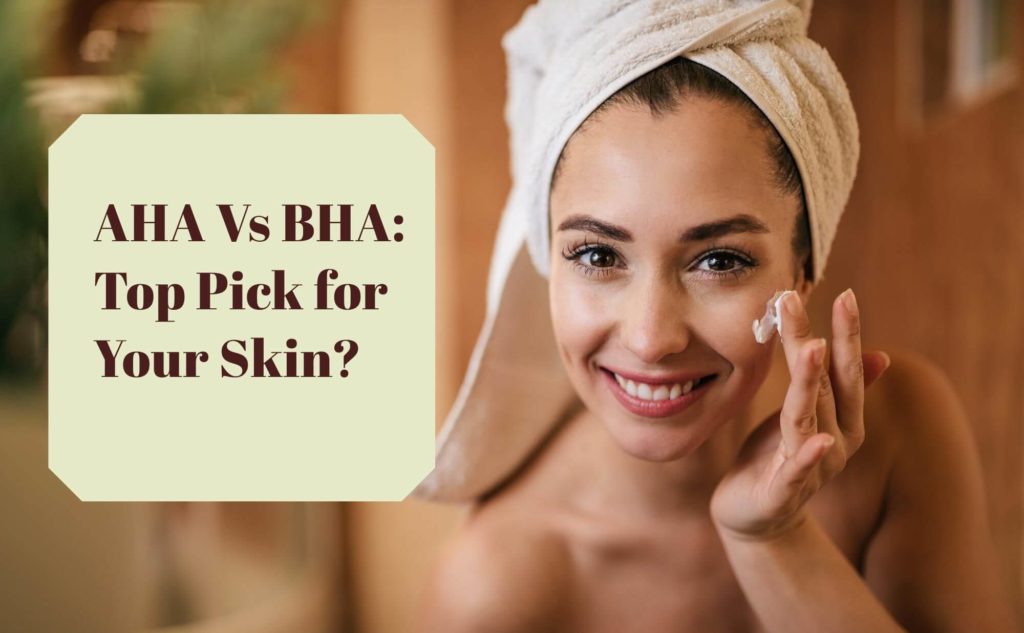AHA is an abbreviation for alpha-hydroxy acid, whereas BHA is an abbreviation for beta-hydroxy acid. AHA and BHA are hydroxy acids used to treat skin problems including acne.
Glycolic acid, lactic acid, and salicylic acid are the most prevalent hydroxy acids. These substances can be found in several cosmetic products that claim to treat various skin diseases and improve skin attributes.
Choosing the best product to achieve a given objective might be difficult. We are here to explore the difference between AHA vs BHA and what is the best way to use both.
AHA vs BHA
Glycolic acid, citric acid, malic acid, tartaric acid, and lactic acid are the weak acids that are present in the AHA that might help in the treatment of the skin’s appearance. Skin peels are filled with the goodness of AHA curing acne, scars, roughness, age spots, seborrhea, melasma, and hyperpigmentation.
On the other hand, BHA is used to reduce the blemishes and signs of premature aging such as wrinkles, fine lines, and the overall texture. Salicylic acid, a form of BHA, is a frequent ingredient in acne treatment solutions.
Among the several BHAs are the acid salicylic, tropic acid, beta-hydroxybutyric acid, and Trichloroacetic acid.
What are the Benefits of AHA Vs BHA- The Popular Hydroxy Acids?
One of the most well-known advantages of hydroxy acids is their capacity to repair sun-damaged skin.. Doctors examine skin roughness, color changes, and collagen density to assess progress in sun-damaged skin.
Because of the stated benefits of hydroxy acids, numerous cosmetic companies have created products that include them.
AHAs operate by lowering the calcium ion concentration in the skin. This encourages the shedding of skin cells at the skin’s surface. BHAs are likewise skin-peeling agents, but salicylic acid also possesses antimicrobial properties.
Despite several studies on AHA vs BHA, professionals still lack sufficient knowledge of their safety as well as their effectiveness. Studies often employ products with varied active components and instructions for usage, making product comparison difficult.

Many hydroxy acid-containing products are exfoliants and moisturizers. Low doses can also be found in over-the-counter medication creams and lotions. Higher quantities of hydroxy acids can be found in chemical peels used to treat skin growths, calluses, photoaging, acne, and psoriasis.
AHA vs BHA – What’s the Difference?
Both AHAs and BHAs are exfoliants, but each hydroxy acid has unique qualities that make it better suited for treating specific skin disorders or improving specific skin traits. Salicylic acid produces less irritation than AHA glycolic acid.
Another difference between AHA vs BHA is that BHAs boost the skin’s resistance to UV damage while also having antimicrobial properties. Because of their antibacterial properties, BHAs are ideal components for acne treatments.
AHAs provide more intense exfoliation, which may be better suited for healing sun-damaged skin and counteracting the symptoms of aging. They also influence collagen and procollagen synthesis. These are compounds that can help photoaged skin look younger. Because AHAs are more aggressive, they should be used with caution due to the risk of sun sensitivity.
Your Top Pick
A person’s skin product selection should be based on which hydroxy acid is best suited to their unique needs. Because of its antibacterial qualities, BHA appears to be more effective in treating skin disorders such as acne.
AHAs like glycolic and lactic acid may be useful in treating skin color changes like melasma, solar lentigines, and hyperpigmentation following an injury. According to experts, the faster action of AHA results in a better choice for enhancing skin color than BHA-containing solutions.
AHA-containing solutions may also be preferred by persons wanting to treat sun-damaged or aging skin due to their more aggressive method of action and effects on collagen. Lactic acid, another AHA, works well as a moisturizer.
It is worth noting, however, that much of the previous evidence appears to have been acquired from trials in which participants had lighter-colored skin. Further research is needed to determine the safety and effectiveness of these items in individuals with darker skin tones.
Summary
Because of the purported benefits, many skin care companies use hydroxy acid components in their products.
Both AHA and BHA exfoliate the skin. AHA helps in correcting skin pigmentation disorders. BHA is less harsh and irritating, and it also has antimicrobial effects. AHA and BHA both help to heal sun-damaged skin.
AHA Vs BHA FAQ’s-
Can I use AHA BHA every day?
Depending on the type of your skin, AHA BHA can be used every day, or even twice a day if it suits your skin.
Does one need to use AHA and BHA together?
No, it's not necessary to use both AHA and BHA together. As both perform different functions you can pick the one with the healing properties you need in your skincare regime at the moment.
Is BHA good for oily and acne-prone skin?
Yes, BHA is especially recommended by doctors for the people with oily, acne-prone skin including sensitive skin as it helps reduce the blemishes and heals the skin radiantly.
Can I leave AHA BHA on my skin overnight?
No. After applying an AHA BHA peel, only leave it for 10 minutes before washing and locking the goodness with a nourishing moisturizer and sunscreen.

